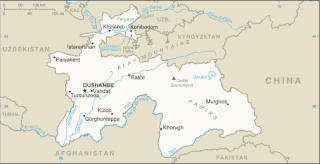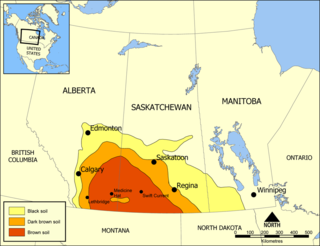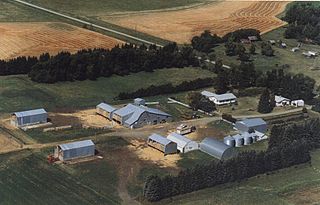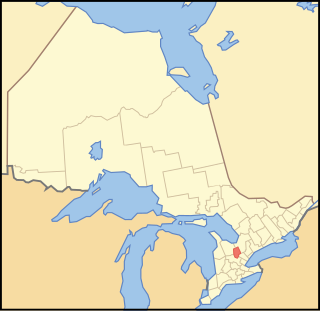Related Research Articles

Agriculture is the practice of cultivating plants and livestock. Agriculture was the key development in the rise of sedentary human civilization, whereby farming of domesticated species created food surpluses that enabled people to live in cities. The history of agriculture began thousands of years ago. After gathering wild grains beginning at least 105,000 years ago, nascent farmers began to plant them around 11,500 years ago. Pigs, sheep, and cattle were domesticated over 10,000 years ago. Plants were independently cultivated in at least 11 regions of the world. Industrial agriculture based on large-scale monoculture in the twentieth century came to dominate agricultural output, though about 2 billion people still depended on subsistence agriculture.

Ontario is one of the thirteen provinces and territories of Canada. Located in Central Canada, it is Canada's most populous province, with 38.3 percent of the country's population, and is the second-largest province by total area. Ontario is Canada's fourth-largest jurisdiction in total area when the territories of the Northwest Territories and Nunavut are included. It is home to the nation's capital city, Ottawa, and the nation's most populous city, Toronto, which is also Ontario's provincial capital.

Rural flight is the migratory pattern of peoples from rural areas into urban areas. It is urbanization seen from the rural perspective.

Tajikistan is nestled between Kyrgyzstan and Uzbekistan to the north and west, China to the east, and Afghanistan to the south. Mountains cover 93 percent of Tajikistan's surface area. The two principal ranges, the Pamir Mountains and the Alay Mountains, give rise to many glacier-fed streams and rivers, which have been used to irrigate farmlands since ancient times. Central Asia's other major mountain range, the Tian Shan, skirts northern Tajikistan. Mountainous terrain separates Tajikistan's two population centers, which are in the lowlands of the southern and northern sections of the country. Especially in areas of intensive agricultural and industrial activity, the Soviet Union's natural resource utilization policies left independent Tajikistan with a legacy of environmental problems.

Uzbekistan is a country of Central Asia, located north of Turkmenistan and Afghanistan. With an area of 447,000 square kilometers, Uzbekistan stretches 1,425 km (885 mi) from west to east and 930 km (580 mi) from north to south. It borders Turkmenistan to the southwest, Kazakhstan to the north, and Tajikistan and Kyrgyzstan to the south and east.

Organic farming is an agricultural system that uses fertilizers of organic origin such as compost manure, green manure, and bone meal and places emphasis on techniques such as crop rotation and companion planting. It originated early in the 20th century in reaction to rapidly changing farming practices. Certified organic agriculture accounts for 70 million hectares globally, with over half of that total in Australia. Organic farming continues to be developed by various organizations today. Biological pest control, mixed cropping and the fostering of insect predators are encouraged. Organic standards are designed to allow the use of naturally-occurring substances while prohibiting or strictly limiting synthetic substances. For instance, naturally-occurring pesticides such as pyrethrin and rotenone are permitted, while synthetic fertilizers and pesticides are generally prohibited. Synthetic substances that are allowed include, for example, copper sulfate, elemental sulfur and Ivermectin. Genetically modified organisms, nanomaterials, human sewage sludge, plant growth regulators, hormones, and antibiotic use in livestock husbandry are prohibited. Organic farming advocates claim advantages in sustainability, openness, self-sufficiency, autonomy and independence, health, food security, and food safety.

Resource depletion is the consumption of a resource faster than it can be replenished. Natural resources are commonly divided between renewable resources and non-renewable resources. Use of either of these forms of resources beyond their rate of replacement is considered to be resource depletion. The value of a resource is a direct result of its availability in nature and the cost of extracting the resource, the more a resource is depleted the more the value of the resource increases. There are several types of resource depletion, the most known being: Aquifer depletion, deforestation, mining for fossil fuels and minerals, pollution or contamination of resources, slash-and-burn agricultural practices, soil erosion, and overconsumption, excessive or unnecessary use of resources.

Conservation agriculture (CA) can be defined by a statement given by the Food and Agriculture Organization of the United Nations as "A farming system that promotes minimum soil disturbance, maintenance of a permanent soil cover, and diversification of plant species. It enhances Biodiversity and natural biological processes above and below the ground surface, which contribute to increased water and nutrient use efficiency and to improved and sustained crop production."

Agriculture is a major industry in the United States, which is a net exporter of food. As of the 2017 census of agriculture, there were 2.04 million farms, covering an area of 900 million acres (1,400,000 sq mi), an average of 441 acres per farm.

Kentville is a town in Kings County, Nova Scotia. It is one of the main towns in the Annapolis Valley, and it is the county seat of Kings County. As of 2016, the town's population was 6,271. Its census agglomeration is 26,222.

Palliser's Triangle, or the Palliser Triangle, is a semi-arid steppe occupying a substantial portion of the Western Canadian Prairie Provinces, Saskatchewan, Alberta and Manitoba, within the Great Plains region. While initially determined to be unsuitable for crops outside of the fertile belt due to arid conditions and dry climate, expansionists questioned this assessment, leading to homesteading in the Triangle. Agriculture in the region has since suffered from frequent droughts and other such hindrances.

The Canadian Prairies is a region in Western Canada. It includes the Canadian portion of the Great Plains and the Prairie Provinces, namely Alberta, Saskatchewan, and Manitoba. These provinces are partially covered by grasslands, plains, and lowlands, mostly in the southern regions. The northernmost reaches of the Canadian Prairies are less dense in population, marked by forests and more variable topography. If the region is defined to include areas only covered by prairie land, the corresponding region is known as the Interior Plains. Physical or ecological aspects of the Canadian Prairies extend to northeastern British Columbia, but that area is not included in political use of the term.

Dufferin County is a county and census division located in Central Ontario, Canada. The county seat is Orangeville, and the current Warden is Darren White. The current chief administrative officer is Sonya Pritchard. Dufferin covers an area of 1,486.31 square kilometres (573.87 sq mi), and its population was 61,735 at the time of the 2016 Census.

Global change refers to planetary-scale changes in the Earth system. The system consists of the land, oceans, atmosphere, polar regions, life, the planet's natural cycles and deep Earth processes. These constituent parts influence one another. The Earth system now includes human society, so global change also refers to large-scale changes in society and the subsequent effects on the environment.

Agriculture, farming, and fishing form the primary sector of industry of the Japanese economy together with the Japanese mining industry, but together they account for only 1.3% of gross national product. Only 20% of Japan's land is suitable for cultivation, and the agricultural economy is highly subsidized.
Forest transition refers to a geographic theory describing a reversal or turnaround in land-use trends for a given territory from a period of net forest area loss to a period of net forest area gain. The term "landscape turnaround" has also been used to represent a more general recovery of natural areas that is independent of biome type.
Increasing biodiversity in agriculture may increase the sustainability of the farm.

The environmental impact of agriculture is the effect that different farming practices have on the ecosystems around them, and how those effects can be traced back to those practices. The environmental impact of agriculture varies widely based on practices employed by farmers and by the scale of practice. Farming communities that try to reduce environmental impacts through modifying their practices will adopt sustainable agriculture practices. The negative impact of agriculture is an old issue that remains a concern even as experts design innovative means to reduce destruction and enhance eco-efficiency. Though some pastoralism is environmentally positive, modern animal agriculture practices tend to be more environmentally destructive than agricultural practices focused on fruits, vegetables and other biomass. The emissions of ammonia from cattle waste continues to raise concerns over environmental pollution.
The gender gap in Pakistan refers to the relative disparity between male and female citizens in Pakistani society along key indicators and aspects of life. It can be assessed through a number of facets, ranging from demographic disparities to legal discrimination, economic inequality, and cultural attitudes.

Lenore Fahrig is a Chancellor's Professor in the biology department at Carleton University, Canada and a Fellow of the Royal Society of Canada. Fahrig studies effects of landscape structure—the arrangement of forests, wetlands, roads, cities, and farmland—on wildlife populations and biodiversity, and is best known for her work on habitat fragmentation.
References
- 1 2 Sandström, Vilma; Saikku, Laura; Antikainen, Riina; Sokka, Laura; Kauppi, Pekka (15 April 2014). "Changing impact of import and export on agricultural land use: The case of Finland 1961–2007". Agriculture, Ecosystems & Environment. 188: 163–168. doi:10.1016/j.agee.2014.02.009.
- 1 2 Charles Geisler; Ben Currens (20 December 2013). ""Peak Farmland": Revealed Truth or Recreancy?". William R. Freudenburg, A Life in Social Research. Research in Social Problems and Public Policy. 21. Emerald Group Publishing Limited. pp. 177–199. doi:10.1108/s0196-1152(2013)0000021012. ISBN 978-1-78190-734-4.
- ↑ "What is peak farmland?". Kate Prengaman. 8 January 2013. Archived from the original on 24 October 2016. Retrieved 24 October 2016.
- ↑ Sandström, Vilma; Saikku, Laura; Antikainen, Riina; Sokka, Laura; Kauppi, Pekka (15 April 2014). "Changing impact of import and export on agricultural land use: The case of Finland 1961–2007". Agriculture, Ecosystems & Environment. 188: 163–168. doi:10.1016/j.agee.2014.02.009.
- 1 2 ""Peak farmland" is here, crop area to diminish: study". Reuters. 17 December 2016. Retrieved 18 October 2016.
- ↑ Poore, Joseph (January 2016). "Call for conservation: Abandoned pasture". Science. 351 (6269): 132. Bibcode:2016Sci...351..132P. doi:10.1126/science.351.6269.132-a. PMID 26744398.
- ↑ "The Return of Nature – How Technology Liberates the Environment". thebreakthrough.org. Retrieved 24 October 2016.
- 1 2 Johan Norberg (1 September 2016). Progress: Ten Reasons to Look Forward to the Future. Oneworld Publications. p. 236. ISBN 978-1-78074-951-8.
- 1 2 Robert Bryce (13 May 2014). Smaller Faster Lighter Denser Cheaper: How Innovation Keeps Proving the Catastrophists Wrong. PublicAffairs. p. 151. ISBN 978-1-61039-206-8.
- ↑ "Are We Close to Peak Farmland? | Conservancy Talk". Conservancy Talk. 22 January 2013. Retrieved 24 October 2016.
- ↑ Jesse H. Ausubel, Peak Farmland, Lecture for the 18 December 2012 Symposium in Honor of the 80th Birthday of Paul Demeny and his retirement as editor of Population and Development Review